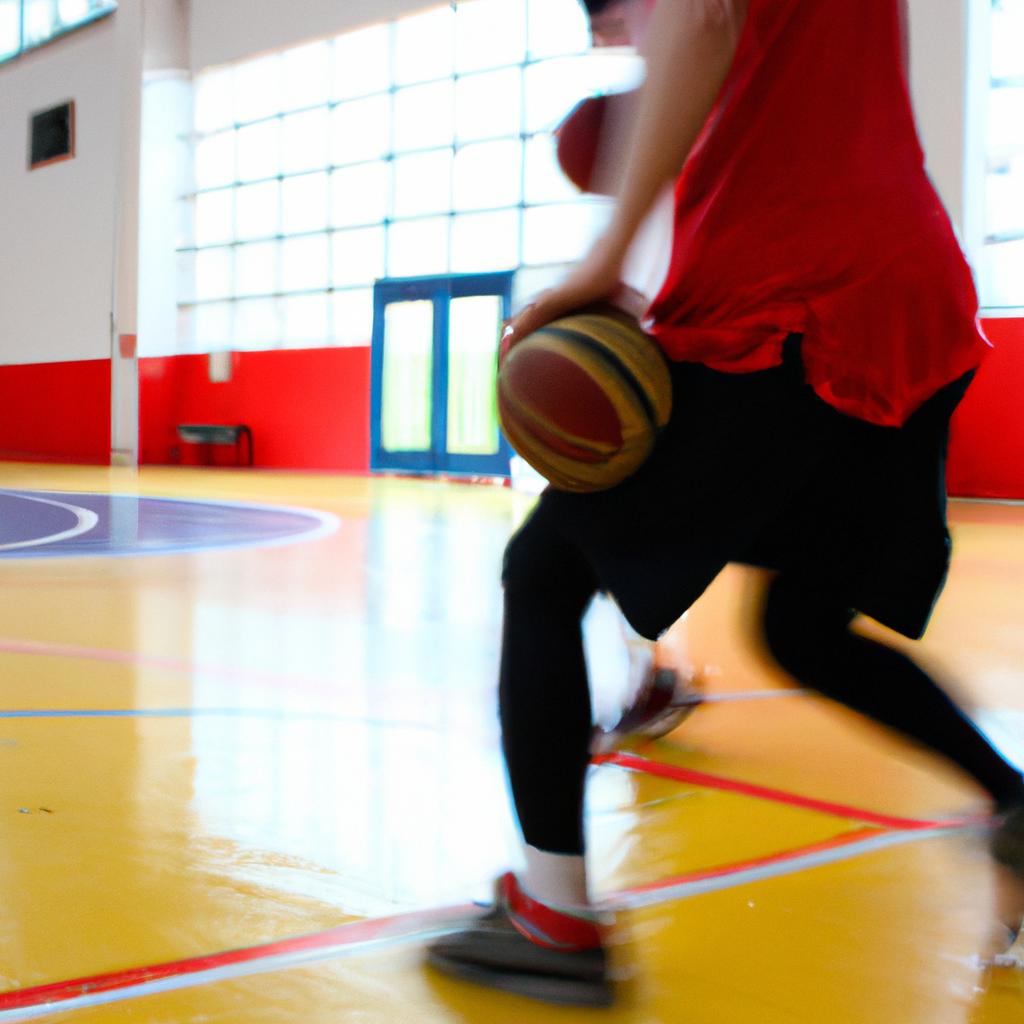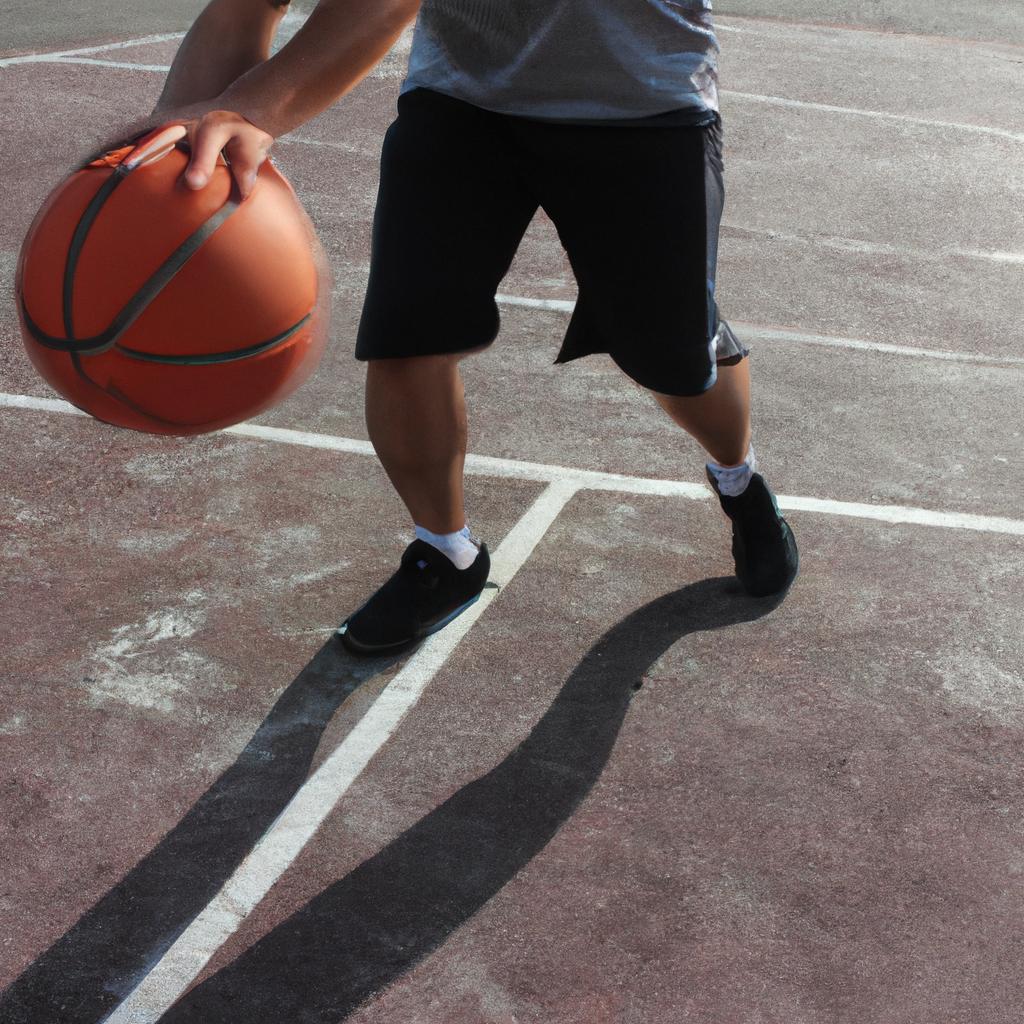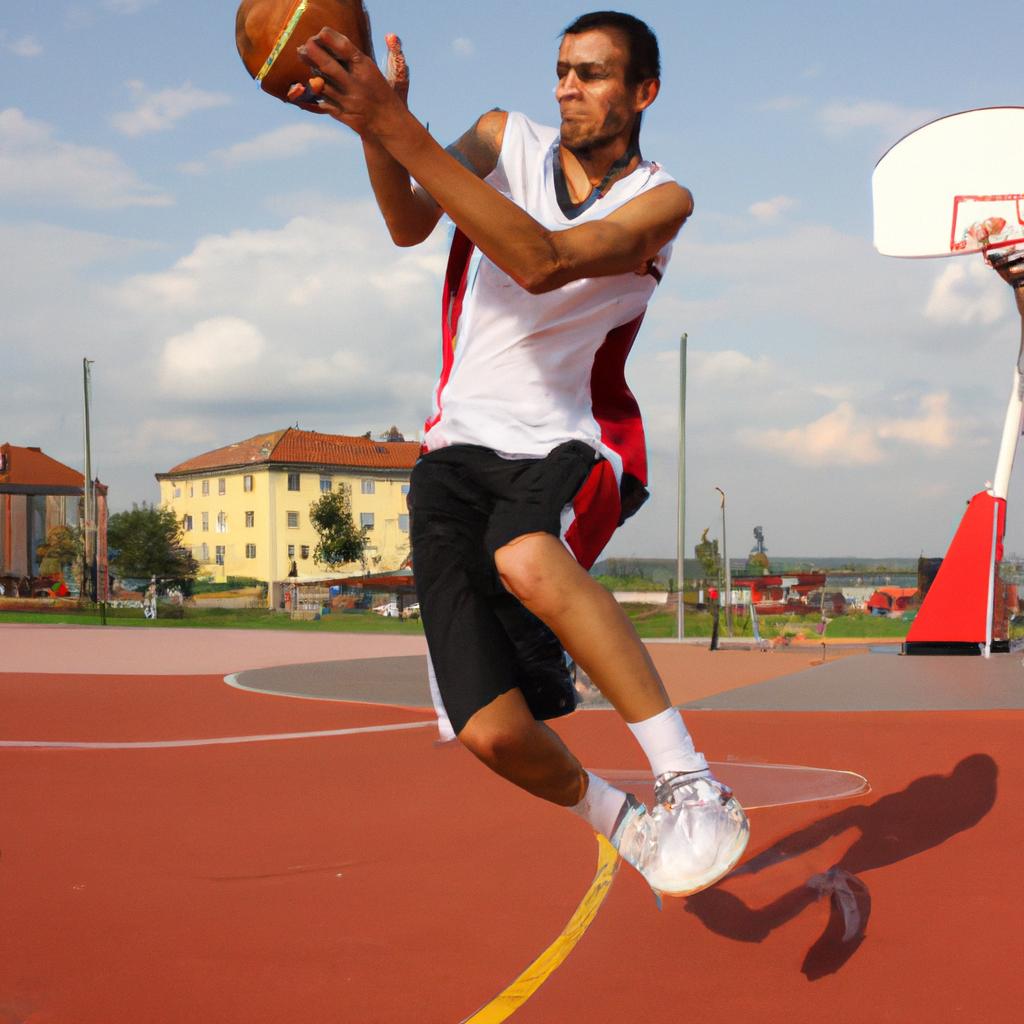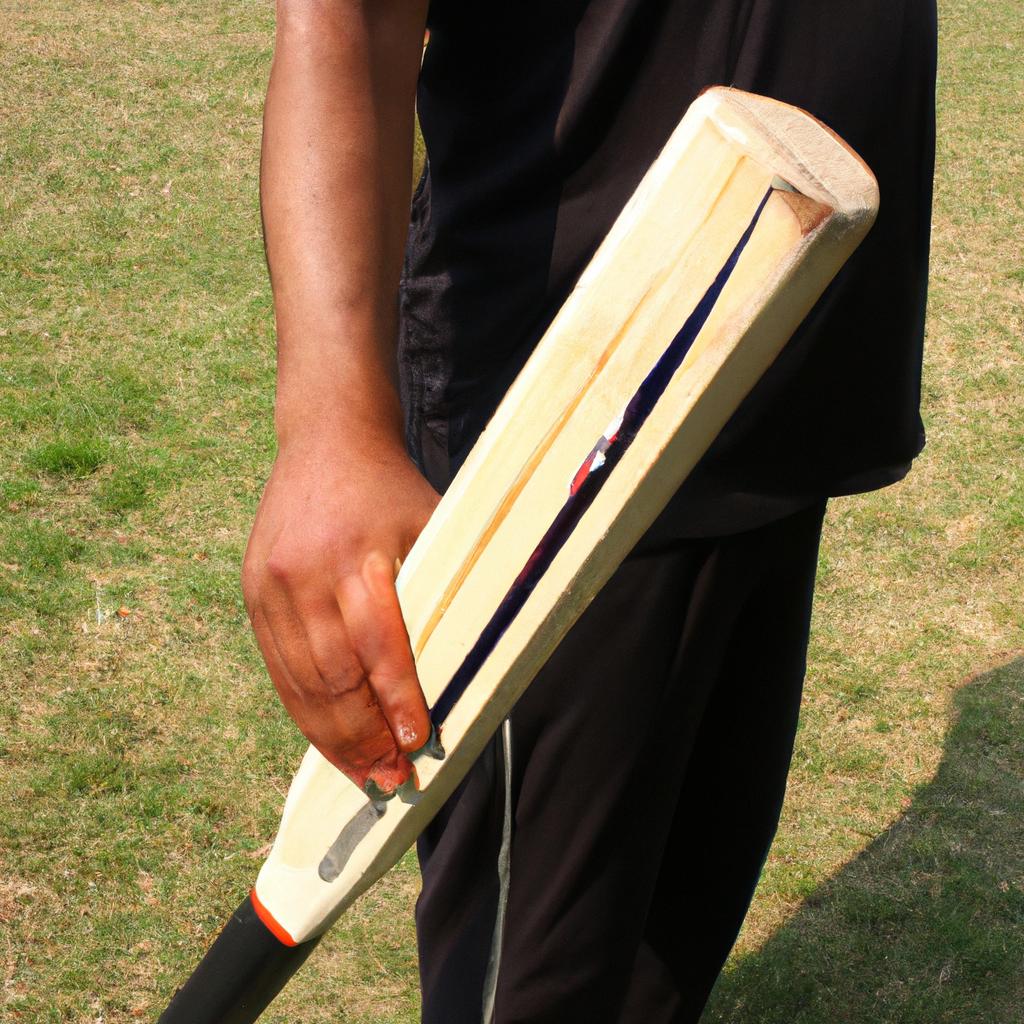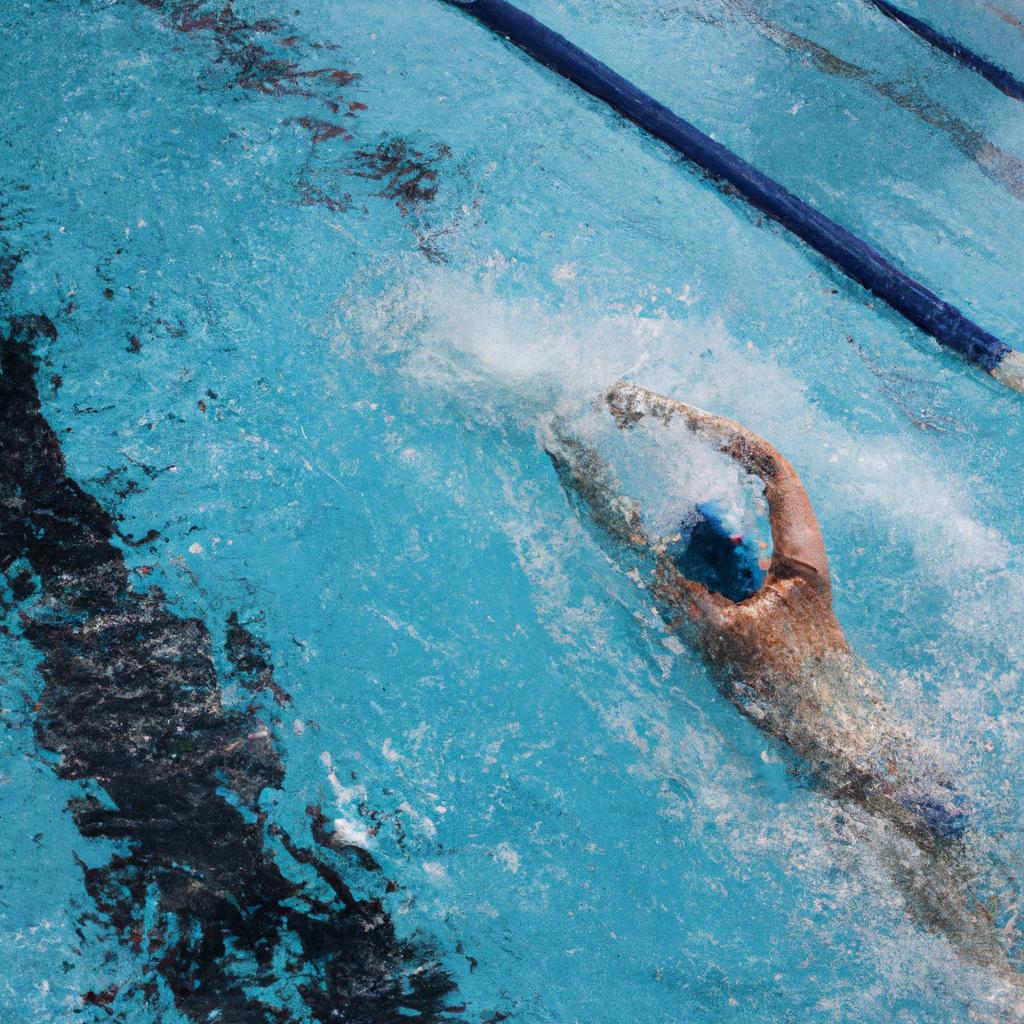Basketball is a dynamic sport that requires players to possess not only offensive prowess but also defensive skills to effectively compete. The ability to defend against opponents’ attacks and disrupt their strategies can significantly impact the outcome of basketball games. This article aims to delve into the realm of defensive tactics in basketball, unveiling dominating strategies that can elevate teams’ performance on the court.
To illustrate the importance of effective defensive tactics, consider a hypothetical scenario where Team A is facing off against Team B in a high-stakes basketball game. Both teams are evenly matched in terms of offensive capabilities, making it crucial for each team’s defense to step up and make a difference. In this case, if Team A implements superior defensive strategies such as tight man-to-man marking, strategic positioning, and swift rotations, they have a greater chance of suppressing Team B’s scoring opportunities and gaining an advantage in the game. Thus, understanding and implementing dominant defensive tactics can prove to be instrumental in achieving victory on the basketball court.
In this article, we will explore various aspects of defensive tactics that contribute to successful performances in basketball games. By examining different methods such as zone defenses, full-court presses, trapping techniques, and help-side principles, we aim to provide comprehensive insights into how teams can enhance their defensive performance and dominate their opponents. These defensive tactics can be employed both individually and collectively to disrupt the flow of the opposing team’s offense and create turnovers, leading to scoring opportunities for the defending team.
Zone defenses are a commonly used tactic in basketball, where players guard specific areas on the court rather than individual opponents. This strategy allows teams to defend against multiple offensive threats simultaneously, making it difficult for opponents to find open spaces or pass the ball effectively. By understanding zone defense principles such as maintaining proper spacing, communication, and quick rotations, teams can effectively neutralize their opponents’ offensive strategies and force them into low-percentage shots.
Full-court presses are another aggressive defensive tactic that aims to apply intense pressure on the opposing team throughout the entire court. By employing this strategy, teams aim to disrupt their opponents’ ability to bring the ball up the court smoothly and initiate their offense. Full-court presses involve players closely guarding their assigned opponents, trapping ball handlers near sidelines or corners, and forcing turnovers through interceptions or deflections. This high-pressure approach can rattle opposing teams and force them into making hasty decisions or committing turnovers.
Trapping techniques involve strategically double-teaming an opponent with two defenders in an attempt to force turnovers or create difficult passing angles. Traps can be set in various areas on the court, such as near half-court or along the baseline, depending on where the opposition is most vulnerable. Proper execution of trapping techniques requires precise timing, coordination between defenders, and anticipation of passing lanes.
Help-side principles refer to defensive strategies that emphasize providing support from off-ball defenders to stop penetration or help teammates defend against strong offensive players. Help-side defense involves players being aware of their positioning relative to both their assigned opponent and potential threats on the court. By effectively rotating and providing timely help when needed, teams can disrupt opponent’s drives to the basket while also recovering quickly to contest outside shots.
In conclusion, dominant defensive tactics play a crucial role in the outcome of basketball games. By implementing strategies such as zone defenses, full-court presses, trapping techniques, and help-side principles, teams can effectively disrupt their opponents’ offensive flow and create scoring opportunities for themselves. It is essential for players to understand these defensive tactics, communicate effectively with their teammates, and execute them with precision to achieve success on the basketball court.
Understanding Defensive Positions
Understanding Defensive Positions
Imagine a basketball game where the opposing team has possession of the ball. As a defensive player, you find yourself positioned near the key, facing an offensive player who is known for his exceptional shooting skills. You know that your role in this moment is crucial – to prevent him from scoring and regain control for your team. This scenario exemplifies the importance of understanding defensive positions in basketball.
To effectively defend against different offensive strategies, players must be well-versed in various defensive positions and their corresponding responsibilities. By mastering these positions, defenders can anticipate plays, disrupt passing lanes, contest shots, and ultimately thwart the opponent’s scoring attempts. Let us delve into three fundamental defensive positions: point guard defender, wing defender, and post defender.
The point guard defender typically guards the opposing team’s primary playmaker – often characterized by agility, quickness, and excellent ball-handling skills. Their role involves applying pressure on the ball-handler to impede dribble penetration while staying mindful of potential passes to open teammates. In essence, they are responsible for setting the tone of defensive intensity right from the start.
As we move further along our exploration of defensive positions, let’s consider the responsibilities of a wing defender. Positioned on either side of the court beyond the three-point line, they guard perimeter players whose main objective may involve taking outside shots or driving towards the basket. Wing defenders need to possess good lateral movement skills combined with solid anticipation abilities to deny shot opportunities and close out quickly when needed.
Lastly, we have the post defender, primarily assigned to protect areas closer to the basket such as underneath it or around it within what is commonly called “the paint.” Against opponents with strong inside presence such as centers or power forwards who excel at low-post moves or rebounding efforts, effective post defense becomes paramount. Post defenders rely on strength, positioning techniques like fronting or denying entry passes into
Mastering Man-to-Man Defense
Transitioning from the previous section, where we explored the intricacies of defensive positions, our attention now turns to mastering man-to-man defense. To illustrate its effectiveness, let us consider a hypothetical scenario: Team A is facing off against Team B in a crucial basketball game. The score is tied with only two minutes left on the clock. Understanding and implementing effective man-to-man defense becomes essential for Team A to secure victory.
When executing man-to-man defense, players are assigned specific opponents to guard throughout the game. This strategy aims to deny offensive players any space or opportunities by closely marking them at all times. It requires exceptional individual skills such as agility, footwork, and anticipation.
To delve deeper into the nuances of man-to-man defense, here are some key points to remember:
- Communication: Effective communication among teammates is vital in ensuring seamless switches between defenders and maintaining coverage on offensive threats.
- Denial Defense: Employing denial techniques prevents easy passes and restricts an opponent’s access to their preferred areas on the court.
- Help Defense: Even when guarding one player individually, it is crucial for defenders to be aware of potential scoring threats from other offensive players and provide timely assistance if needed.
- Defensive Transition: Quick transition from offense to defense allows teams employing man-to-man defenses to set up early and prevent fast breaks or easy baskets.
To further illustrate these concepts, refer to the table below that depicts how each defender matches up against their respective opponents:
| Player | Opponent |
|---|---|
| Player 1 | Opponent 1 |
| Player 2 | Opponent 2 |
| Player 3 | Opponent 3 |
| Player 4 | Opponent 4 |
By meticulously adhering to these principles while executing man-to-man defense, Team A can effectively neutralize their opponents’ scoring prowess. Maintaining constant pressure and denying passing lanes will force turnovers and disrupt the flow of Team B’s offense. As we move forward into the subsequent section on implementing zone defense strategies, it is essential to understand that mastering man-to-man defense serves as a solid foundation for any defensive approach.
Transitioning seamlessly into the next section about “Implementing Zone Defense Strategies,” coaches and players alike must now expand their understanding beyond individual matchups to develop effective team-based defensive tactics.
Implementing Zone Defense Strategies
Transitioning from the mastery of man-to-man defense, let us now delve into implementing effective zone defense strategies. Imagine a scenario where your team is facing off against a formidable opponent known for their superior shooting skills. By employing zone defense, you can strategically position your players to disrupt their offensive plays and gain an advantage on the court.
One example of how zone defense can be utilized effectively is by implementing the 2-3 zone formation. In this setup, two defenders guard near the perimeter while three others cover the key area close to the basket. This formation aims to limit opponents’ access to high-percentage scoring opportunities and force them to take shots from less advantageous positions on the court.
To successfully implement zone defense, consider these key factors:
- Communication: Effective communication among teammates is essential in maintaining proper positioning within the designated zones.
- Quick rotations: Swift movement and seamless transitions between different areas are crucial when opponents attempt to penetrate or pass through gaps in the zone’s coverage.
- Active hands: Constantly contesting passes and disrupting ball movement helps create turnovers and prevents easy baskets.
- Rebounding discipline: Maintaining rebounding responsibilities ensures that second-chance opportunities are minimized.
Emphasizing these aspects will greatly enhance your team’s defensive capabilities when implementing a well-executed zone defense strategy.
| Key Points | Benefits | Challenges |
|---|---|---|
| Restricts penetration | Limits high-percentage shots | Requires constant rotation |
| Forces long-range | Creates confusion | Vulnerable against skilled |
| shots | outside shooters | |
| Provides help | Increases chances | Weakens individual guarding |
| defense | of securing rebounds | – |
By incorporating these tactics into your defensive game plan, you can effectively disrupt opponents’ offensive plays and maintain control on both ends of the court. Transitioning seamlessly into our next section on disrupting opponent’s offensive plays, we will explore additional strategies to further enhance your team’s defensive prowess.
Disrupting Opponent’s Offensive Plays
After mastering the implementation of zone defense strategies, teams can further enhance their defensive prowess by focusing on disrupting opponent’s offensive plays. By effectively countering and neutralizing an adversary’s attack tactics, a team can significantly diminish their scoring opportunities and gain control of the game. To illustrate this concept, let us consider a hypothetical scenario where Team A successfully disrupts Team B’s offensive plays through strategic defensive maneuvers.
In our hypothetical scenario, Team A faces off against Team B in a high-stakes basketball match. Recognizing that Team B heavily relies on pick-and-roll plays to penetrate their defense, Team A employs several disruptive techniques to impede their opponents’ progress:
-
Switching defenders: Instead of allowing Team B’s ball handler to exploit mismatches created by screens, Team A quickly switches defenders when necessary. This forces the offense to adjust its strategy and find new ways to create scoring opportunities.
-
Denying passing lanes: By actively denying passes between players on opposing teams, Team A disrupts the flow of play and limits options for effective ball movement. This tactic puts pressure on the offense and increases the likelihood of turnovers or forced shots.
-
Applying traps and double-teams: When facing particularly skilled offensive players who pose significant threats, such as prolific scorers or exceptional passers, Team A implements well-timed traps and double-team defenses. These aggressive defensive actions force hurried decisions and reduce the effectiveness of individual offensive talents.
-
Contesting shots with discipline: Effective disruption also involves challenging every shot attempt without fouling unnecessarily. By maintaining disciplined defense while contesting shots, Team A instills doubt in the minds of opposing shooters, potentially leading to missed shots or altered shooting mechanics.
To further emphasize how disruptive defensive tactics impact gameplay dynamics, consider Table 1 below:
| Defensive Tactics | Impact |
|---|---|
| Switching defenders | Forces offense to adapt |
| Denying passing lanes | Limits offensive options |
| Applying traps and double-teams | Creates hurried decisions |
| Contesting shots with discipline | Instills doubt in shooters |
Through the strategic implementation of these tactics, Team A successfully disrupts Team B’s offensive plays, gaining an advantage in their pursuit of victory. By employing a combination of switching defenders, denying passing lanes, applying traps and double-teams, as well as contesting shots with discipline, teams can effectively neutralize opponents’ offenses.
In the subsequent section on Effective Communication on Defense, we will explore how cohesive communication among teammates complements disruptive defensive strategies, allowing for even greater effectiveness in thwarting opponent’s scoring attempts.
Effective Communication on Defense
Transitioning from disrupting the opponent’s offensive plays, we now turn our attention to another crucial aspect of defensive tactics: effective communication on defense. To illustrate its significance, let us consider a hypothetical scenario where Team A is facing off against Team B in a high-stakes basketball game.
In this case, Team A recognizes the importance of clear and concise communication among its players during defensive situations. By effectively communicating through verbal cues and hand signals, they are able to coordinate their movements seamlessly and disrupt their opponents’ offensive strategies. This level of cohesion allows them to anticipate plays, switch defenders when necessary, and maintain an organized defensive structure throughout the game.
To emphasize the role of communication in successful defense, here are four key reasons why it is vital:
- Enhanced Awareness: Clear communication ensures that all teammates are aware of potential threats on the court, such as screens or backdoor cuts. Through verbal instructions and non-verbal gestures like pointing or signaling, defenders can alert each other about these tactical maneuvers before they occur.
- Efficient Help Defense: Effective communication enables players to quickly communicate defensive responsibilities when help defense is required. By conveying information regarding rotations and switches, defenders can efficiently provide support to teammates who may be guarding particularly skilled offensive players.
- Seamless Defensive Transitions: Communication also aids in smooth defensive transitions between different formations (e.g., man-to-man or zone defense). Promptly relaying transition calls helps ensure that everyone knows their assignments without confusion or hesitation.
- Unity and Motivation: Strong communication fosters team unity by allowing players to feel connected both mentally and emotionally on the court. It creates an environment where individuals motivate one another, leading to improved performance collectively.
Now let us delve into a table that illustrates various types of common defensive communications alongside their respective meanings:
| Type of Communication | Meaning |
|---|---|
| “Ice” | Force the offensive player towards the sideline or baseline. |
| “Switch” | Exchange defensive assignments between two players guarding different offensive players. |
| “Help” | Alert teammates to provide support in defending a specific player or area on the court. |
| “Ball!” | Inform others that they need to focus their attention on the ball-handler immediately. |
In conclusion, effective communication is an essential component of successful defense in basketball games. By conveying information clearly and concisely, players can enhance awareness, facilitate efficient help defense, maintain seamless transitions, and foster unity within the team. The ability to communicate effectively serves as a foundation for coordinated defensive efforts. Now, let us explore another critical aspect of defensive tactics: utilizing defensive transition.
Utilizing Defensive Transition
Transitioning from effective communication on defense, the art of utilizing defensive transition is crucial in maintaining a strong defensive presence throughout basketball games. By seamlessly transitioning from offense to defense and vice versa, teams can gain a competitive advantage through quick decision-making and strategic positioning. Let’s delve into this essential aspect of defensive tactics by exploring its benefits, techniques, and key considerations.
Imagine a scenario where Team A intercepts the ball while defending against an opposing team’s fast break attempt. In that split second, their focus swiftly shifts towards initiating a counterattack with precision and efficiency. This seamless transition allows them to catch the opponents off guard and capitalize on scoring opportunities before they have time to regroup defensively.
To effectively utilize defensive transition strategies, consider incorporating these key elements:
- Quick Decision-Making: Reacting promptly to turnovers or missed shots enables players to initiate the transition immediately.
- Offensive Awareness: Players should be adept at recognizing potential breaks and exploiting any mismatches created during transitions.
- Communication: Efficiently relaying information among teammates helps maintain cohesion and enhances overall defensive effectiveness during transitional phases.
- Conditioning: Physical fitness plays a significant role in executing swift transitions consistently throughout the game.
The following table showcases how various NBA teams leverage different aspects of defensive transition:
| Team | Fast Break Points per Game | Steals per Game | Deflections per Game |
|---|---|---|---|
| Los Angeles Lakers | 15.3 | 9.8 | 17.1 |
| Miami Heat | 14.6 | 8.4 | 16.5 |
| Golden State Warriors | 13.7 | 8.1 | 15.3 |
| Toronto Raptors | 12.9 | 7.6 | 14.8 |
The statistics above highlight the impact of defensive transition on teams’ success, with higher numbers indicating a greater proficiency in capitalizing on fast break opportunities and disrupting opponents’ offensive flow.
In summary, mastering defensive transition is integral to maximizing a team’s defensive capabilities during basketball games. By swiftly transitioning from offense to defense and employing effective strategies, teams can catch their opponents off guard while maintaining a strong defensive presence throughout the game. Quick decision-making, offensive awareness, communication, and conditioning are all vital components for successful implementation of this essential tactic. Analyzing statistical data further emphasizes the significance of defensive transitions in achieving favorable outcomes on both ends of the court.



